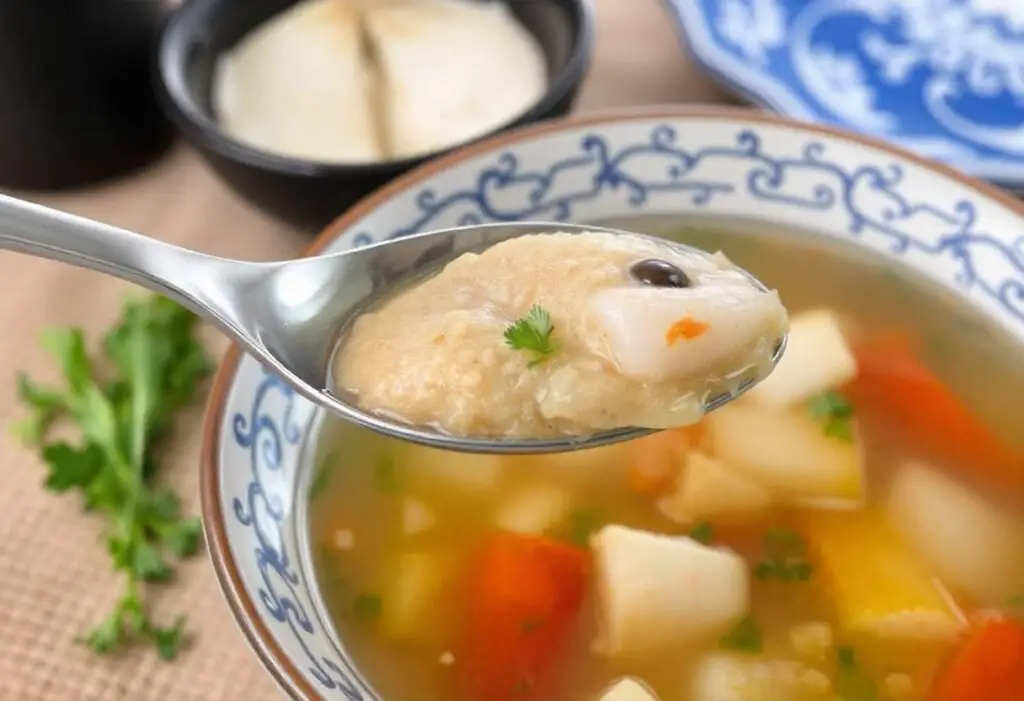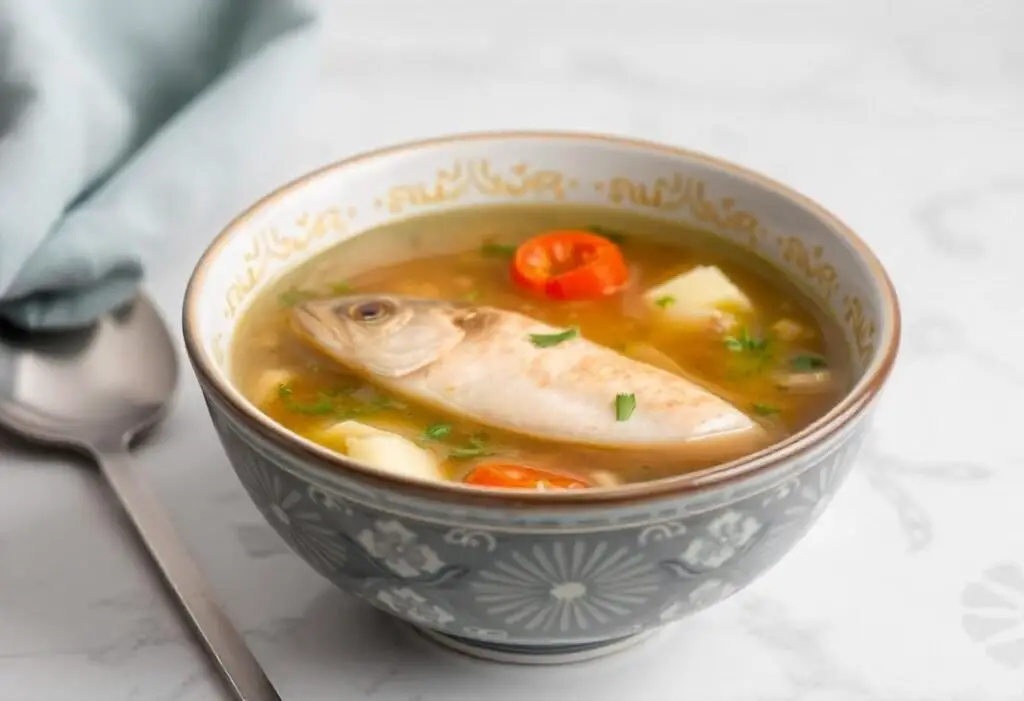Table of Contents
Introduction to Russian Fish Soup: What is Ukha?

More than a dish, Ukha turns into a journey through the rich traditions of Russian culture and their heritage. Whether it is part of the comforting warm meal set to hit the table, this traditional fish soup is very much rooted deep into Russian waters where fishing was part and parcel of life for over a thousand years. Being one of the manifestations of traditional Russian cuisine, Ukha is rich in flavor but simple in ingredients.
It is interesting that originally Ukha was a peasant dish, which was composed of fish caught by hand and fresh vegetables that were available. In the process of time, it became one of the favorite family dishes from Russia. Nowadays, the soup has become a symbol of hospitality, warmth, and richness of nature, and should be tried without fail by anyone interested in genuine Russian cuisine.
Ingredients That Make Russian Fish Soup Shine
To create a bewitching bowl of Russian Fish Soup, you need to collect the right mixture. Ideally, the quality and freshness of the components have everything to do with how great the soup would be.
Essential Fresh Fish Varieties
Of course, the star of the show at Ukha is the fish. Traditionally, a combination of freshwater fish is used – pike, perch, and trout. A favorite is piked, whose meat is tight-fleshed and not too strongly flavored, but slightly sweetened by the addition of perch. To create good Ukha, one has to use very fresh fish, because it could be frozen before. Fragrant Herbs and Spices.
Aromatic Herbs and Spices
Aromatic herbs and spices add so much greatness to your Russian Fish Soup. Dill is most frequently used because it adds a wonderfully bright and fresh note that plays perfectly with the fish. Even parsley and bay leaves can go great, but be parsimonious not to overload the soup; just a little will make it harmonious.
Adding Depth: Vegetables and Other Ingredients
Veggie-tales. One of the main components in creating the flavor profile for Ukha has to be mainly vegetables. The most commonly used ones would be onions, carrots, and potatoes. Onions create a savory flavor base. Carrots add sweetness and a bit of color. Potatoes give it a more substantial texture and help fill it up.
Lemon, peppercorns, and garlic would add depth to the soup. If you want a spicier version, add chili flakes or vinegar, brightening up the soup with a flourish of flavors.
Step-by-Step Guide to Crafting Authentic Russian Fish Soup
While it may be intimidating to go about making this traditional Ukha soup, really, it’s not as hard as it seems to be provided you have a clear step-by-step guide.
Preparation of Ingredients: A Key to Flavor
Prepare first all your ingredients. Clean the fish, gut, and filet the fish, putting aside the bones and head for the broth with it. These would be essential in creating a rich broth by the end. Chop your vegetables-dice the onions, slice the carrots, and cube your potatoes. That way, the actual process of cooking becomes much smoother by being prepared from the very beginning.
Cooking Process: The Art of Balancing Flavors
- Make the Broth: Place the fish bones and head in a large pot, then add cold water. Bring the mixture to a gentle boil and skim off any impurities that rise to the surface. This is the most important step in achieving a clear, clean broth.
- Add Vegetables: Add the chopped onions and carrots to the prepared broth. Let them soften while simmering and bring their flavors into the broth for about 10 minutes.
- Introduce the Fish: Once the vegetables are tender, add the fish pieces together with potatoes. Season them with salt, pepper, and desired herbs. Let this soup simmer gently for another 15–20 minutes, or till the fish cooks through and the flavors settle.
- Finish with Freshness: Add a generous handful of fresh dill and a squeeze of lemon juice towards the end of cooking. Taste and season. Serve hot.
Presentation Tips: Making Your Ukha Visually Appealing
For service, Ukha is all about presentation. Garnish it with some good vibrant colors in the bowl. Give it a sprig of fresh dill and a lemon wedge. Sometimes you might want to have some crusty bread alongside for dipping, all set for a show!
Check Out: Shrimp Stock: Elevate Your Seafood Dishes!
Variations of Russian Fish Soup: Explore Regional Twists

Although the traditional Ukha is very much appreciated, there are numerous regional modifications in this recipe; therefore, diversity is a feature of Russian cuisine.
Classic vs. Modern Takes on Ukha
Fresh, locally caught fish, along with basic ingredients, are the bread-and-butter staples of the traditional version. However, added complexity through the addition of some seafood, such as shrimp or mussels, marks a modern adaptation. Ventures with different herbs and spices only introduce unique flavors that bring honor to the original.
Creative Additions: From Spices to Accompaniments
Regional variations may also influence the ingredients in Ukha. In different parts, you may find other ingredients added, such as smoked fish. This adds a nice depth and richness to the soup. Some can add the slightest hint of cream to make it feel creamy. Serve with the more traditional Russian rye bread or even blinis for that full dining experience.
Pairing Suggestions: What Goes Well with Russian Fish Soup?
Finish the feeling of savoring your Russian Fish Soup with its matching alternative sides and beverages.
Bread and Accompaniments
There should be a great hunk of crusty bread next to your bowl of Ukha. Rye bread is actually the favorite accompaniment, for its earthy tones are so complementary to the soup. You can also accompany it with blinis topped with sour cream or caviar for an elegant take.
Wine and Beverage Pairings for an Elevated Experience
For the drinks, Sauvignon Blanc and Riesling crisp white wines will be just perfect with the soup with its delicate taste. Light sparkling water with a twist of lemon makes for a refreshing alternative and can add up to a whole experience if you want something non-alcoholic.
Health Benefits of Russian Fish Soup
Ukha is not only scrumptious but also healthy for our system since the nutrients are richly composed through the choice of ingredients.
Nutritional Highlights of Key Ingredients
The fish used in Ukha is an excellent source of lean protein, essential fatty acids of the omega-3 family, and vital vitamins and minerals. These nutrients are used for the betterment of heart health and support good brain activity and total well-being. Adding vegetables to the soup gives it the necessary fiber, vitamins, and antioxidants to become a nourishing choice for every meal.
Why Ukha is a Comforting Choice
A hot bowl of Ukha always warms the heart in cold evenings. It is one of those dishes that warms your body, but it also warms your soul, which is why it is usually chosen for family gatherings and simple cozy dinners. Simplicity and heartiness are what make Ukha one of the most-liked comfort foods in any Russian home.
Conclusion: Embrace the Flavor of Russian Fish Soup
The celebration of flavors and traditions that Ukha symbolizes in Russian cuisine breathes life into history and comforting qualities, making this traditional fish soup a savory dish to explore and share with loved ones. Whichever variation one follows the age-old recipe or one’s variations, each bowl of Ukha carries a flavor of Russia’s legacy.
So, get ready, take the ingredients, and revel in the wonderful flavor of this ancient dish. Here, in your kitchen, there is a warm, inviting aroma of Ukha, just as in all loved, traditional homemade dishes.
For more details: Click Here.
FAQs about Russian Fish Soup
What types of fish are best for making Ukha?
Some of the best fish that can be used in the preparation of Ukha are freshwater varieties such as pike, perch, and trout. The type of fish will give a different flavor and texture, but overall, a mix of these creates the best result.
Can I make a vegetarian version of Russian Fish Soup?
You can also do a vegetarian version by substituting fish with heftier vegetables mushrooms, and vegetable broth. Some seaweed or smoked paprika can add an umami taste to it in order to taste like fish a little.
How can I store and reheat leftover Ukha?
Leftover Ukha should be stored in an airtight container and kept in the refrigerator for up to 2–3 days. Reheat, warming it carefully over low heat on the stovetop, adding a little water or broth if too thick.





